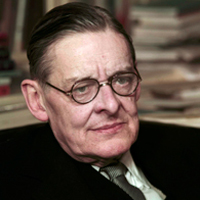Preludes by T. S. Eliot: Critical Analysis
'Preludes' is one of the prominent work of Eliot written in 1910 and 1911. The then society of Eliot is presented as a waste land where corruption and desolation are dominant in the cycle of meaningless life. The title of the poem holds a special position in terms of analysis. Prelude means an introduction to something, to be specific, in a musical sense, it is a small composition that is played before the main piece of music. In that sense, Preludes is just a small window view of the characteristics of the empty society we are shown. In reality the actual society we live in is a terrible place.

T. S. Eliot (1888-1965)
'Preludes' is very effective of Eliot's poems and makes an important contribution to Eliot's development from "Prufrock" to ‘The Waste Land’. Eliot is learning economy, vividness, and the value of impersonality and changes of vision. The mood and tone are vital: these constitute what the poem communicates, and every part of the poem is intended to concentrate the overall impressions of sordid hopelessness, shabbiness, and disenchantment. The gentle comedy of "Prufrock" is gone. Instead of that there is a minor-key poem, an elegy of haunting, tragic intensity, made all the more touching by Eliot's final rejection of his own pity.
Eliot pursues a technique he was very fond of, technique of conveying the dehumanization by fragmenting the human elements of his poem into parts of the body: "muddy feet" and "hands" (Prelude II); hair, the soles of the feet, and "palms of both soiled hands" (Prelude III); "insistent feet", fingers and eyes (Prelude IV). In this way, no complete human soul or human body emerges. All is as mechanical and as dislocated as the action of a robot. It is Eliot's comment in certain moods on human behavior. The technique is greatly developed and expanded in ‘The Waste Land’.
'The Preludes' may appear to be imagistic representations of urban life, recorded without comment, but the objectivity and detachment are illusory. It is difficult to separate the objects of perception from the perceiving consciousness. The lonely cab-horse, the lighting of the lamps, the masquerades that time resumes, are imbued with the emotions of the observer. It is the observer who thinks of weary monotony and sameness of all the hands raising dingy shades, and perceives human beings as dismembered parts of the body—the muddy feet, the hands, the short square fingers, the eyes assured of certain certainties. This fragmentation is a negation of individual identity.
There is a greater complexity of tone and feeling in 'Preludes' III and IV than in I and II. The 'you' of the third 'Prelude' who has `such a vision of the street/ As the street hardly understands' may be a street-walker from Philippe', Marie Donadieu (`Sitting along the bed's edge, where/You curled the papers from your hair') The reader is not given an objective rendering of her perceptions, however. The images are attributed to her consciousness by the controlling voice of the poem. The mind of the 'you' is remorselessly contemplating its own processes and projecting them outwards in the guise of a woman's consciousness. There is a sharper distinction between the perceiving consciousness and the objects of perception in this 'Prelude' than in I and II — between the persona's vision of the street and the street itself. The notion of the soul constituted of a 'thousand sordid images' is a denial of any spiritual dimension to the self.
The opening lines of the fourth 'Prelude' are reminiscent of the evening spread out like a patient etherised upon a table in `Prufrock'. The concept of the soul here is rather different from that in the third `Prelude'. There is a sensation of acute pain and suffering in its being racked across the skies and on the street.
There are religious overtones in the lines, 'The conscience of a blackened street/Impatient to assume the world.' 'Blackness' implies a sense of sin, and 'conscience' of moral discrimination and responsibility. The distinction between subject and object is again blurred whose conscience is it? That of the street, or of the perceiving self? At this, point the poetic voice speaks directly for the first time and admit that it is not detached and impassive. There is a not of compassion and a tentative movement towards religious belief. The notion of some infinitely gentle/Infinitely suffering thing is perhaps a compassionate perception of the suffering inherent in the images around which the poet's fancies are curled, and in the souls constituted by these images. It is a reminder also of the suffering of Christ to redeem the sins of humanity. However, there is a change of tone, sad the religious vision is sardonically brushed aside. It is not entirely obliterated, though. The cynicism, perhaps conceals a nostalgia and wistfulness for an absent ideal. The typographical space emphasizes the gap between the ideal and the actual.
Cite this Page!
Shrestha, Roma. "Preludes by T. S. Eliot: Critical Analysis." BachelorandMaster, 4 Sep. 2017, bachelorandmaster.com/britishandamericanpoetry/preludes-critical-analysis.html.
Related Topics
The Waste Land: Critical Analysis
Journey of the Magi: Summary and Analysis
Morning at the Window: Summary and Analysis
Rhapsody on a Windy Night: Summary and Analysis
The Love Song of J. Alfred Prufrock: Summary
Sweeney among the Nightingales: Analysis
The Hollow Men: Critical Analysis
Portrait of a Lady: Summary and Analysis
Thomas Sterne Eliot: Biography
 |
bachelorandmaster.com |